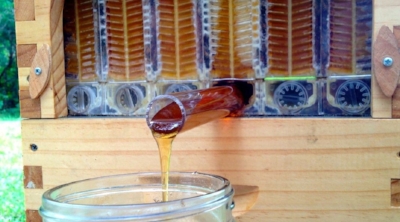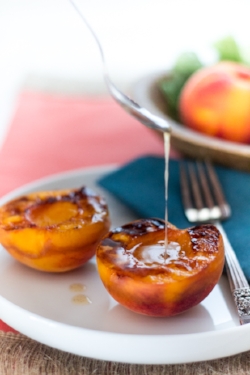The Land of Milk & Honey (But Mostly Honey)

The Land of Milk and Honey (But Mostly Honey)
Honey is u-bee-quitous with a promised land, a cheese platter, and Winnie-the-Pooh. It’s also a nutritious and scrumptious condiment and ingredient, a performance booster, a dressing, beauty product, and healer of wounds! Read on for intel on this liquid gold.
The Current Pickle
Colony Collapse Disorder has put us in quite a pickle because we need bees to pollinate our crops (check out our Almond edition for the deets on CCD), but has CCD also impacted honey production?
In short, not in a noticeable way. The US only produces 30% of the honey it consumes (shout-out to the Dakotas for making honey happen in a big way), and urban beekeeping has exploded in recent years.
Bees in urban hives are actually doing better than their rural cousins and the honey they produce reduces local restaurants' honey purchases.
Check out this bee cam for an intimate look at honey happenings (eat your heart out, puppy cam!).
The honey story gets sweeter still: turns out urban bees are still getting to delicious pollen sources, so the quality of their diet rarely suffers in the urban setting! ➡️ This matters to us because the flavor and color of honey are determined by the flowers the bees visit. 🐝 🌼
Speaking of color: honeys typically fall in a range of golds (the USDA separates the spectrum into seven shades), and though some people think color determines taste (i.e. lighter = milder; darker = stronger), there are many exceptions to that rule.
Bee wary when you start to see colors outside this range—this probably means artificial ingredients have been added or something is amiss…like when a French beekeeper started to see blues and purples appear in his hive. He investigated and found that his bees had been snacking on leftover M&Ms. “Melts in the hive, not in your hand,” anyone? 🙄
What's the Dillio with Choosing A Honey?
So if color isn’t going to determine taste, how else to decide which honey to embrace?
We gotta say, Winnie-the-Pooh got it right: face and hands (paws?) straight into hive/jar.
Basically, the less processing the better.
- Look for raw, unfiltered honey, “because pasteurizing or overheating honey simplifies and changes the subtleties of flavor that are present in raw honey.” And of course, keep your infants away from it.
- Organic is mostly meaningless. Don’t spend extra money for this word—it’s difficult for farmers to prove that their bees only had access to organic flowers, and possibly not true!
- Buy local. Honey is one of the best things to buy from local farmers: it will not only give you a taste of your community, but it avoids the possible contamination that happens frequently with imported honeys. The USDA and FDA do not regulate honey standards closely, so it’s best to know your farmer to trust the source!
- Read the ingredient list. There should be NO added ingredients like high fructose corn syrup.
Honey is defined by the fields the bees pollinated—like blueberry or clover—and one of the most famous is mānuka honey, which researchers have claimed has special antibiotic properties, but “there is no conclusive evidence of medicinal or dietary value.” So save your $$!
Get ready for your jaw to drop when you see how many honey varieties there are, created from bees zipping over different fields, and each with its own flavor profile.
BTW, the real stuff lasts a long time—so invest in your small producer and avoid the grocery store stuff!
The Hot Pickle
Beekeeping is hot. Ever since states lifted a ban on urban beekeeping, keeping bees is now one of the hippest things you can do (and this is not just a US phenomenon!). Producing your own honey while benefiting local agriculture has been an on-trend hobby for nearly a decade.
It’s not too late to get in on apiary activities:
- Subscribe to the Bee Keeper’s Monthly Bee Culture
- Keep the stress down on your bees by investing in a flow hive
- Don a pink apiary suit for your harvesting and regular bee listening activities
BUT if you’re not keeping bees, head to your local farmer’s market to grab a local honey. There are a few online databases to help your hunt for honey: the National Honey Board offers a local search, Local Honey Source, Agrilicious, and even Yelp!
Honey is great around the clock! Check out a few bee-utiful options:
- For breakfast: honey French toast
- For morning snack: honey-orange smoothie
- For lunch: kale salad with honey dressing
- For afternoon snack: butternut squash muffins with honey and dark chocolate chips
- For dinner: honey-paprika glazed steak with onions
- For dessert: honey cake
And in a category of its own: the honey drizzle. We are crushing on the grilled peaches with vanilla-honey drizzle from our friends at The Wanderlust Kitchen.
Sustainable Shout-out to Bolton Bees for thinking outside the hive and installing their apiaries under solar farms—great use of that space under the solar panels!


















